Hi, I’m Bruno, and I’m at the American Museum of Natural History. Today I’m in the fossil halls to interview a titanosaur (tie-TAN-o-SAWR). It’s one of the largest dinosaurs ever discovered!
Let’s find out how this dinosaur lived millions of years ago, how it came to the Museum, and what it’s like to be one of the biggest members of the collection.
Bruno: Tell me more about your cast. How did they make fiberglass copies of real titanosaur bones?
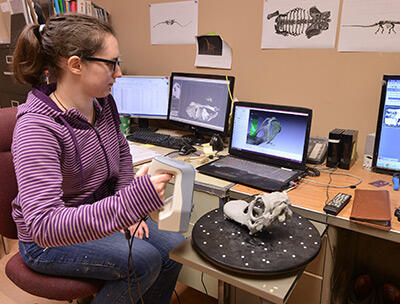
Titanosaur: First, they scanned by fossil bones with a 3-D scanner. With this scan, they made a digital model of my bones on the computer.
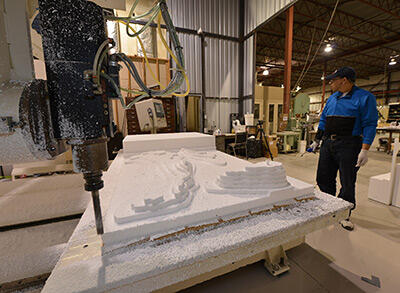
Titanosaur: Next, they used a 3-D printer to make small bones. But for bigger bones, they used a special software program that guides a milling or cutting machine. This is how they carved copies of the bones out of huge slabs of foam. Then they made molds of the bone-shaped foam. Finally, they filled these molds with fiberglass to make the final casts of the bones.
Bruno: Did paleontologists have to find every single bone to know what your skeleton would look like?
Titanosaur: They didn’t find every one, but paleontologists did find 84. They modeled the rest of the bones based on what they know about my close relatives.
Bruno: So once they had the casts of the bones, what happened next?
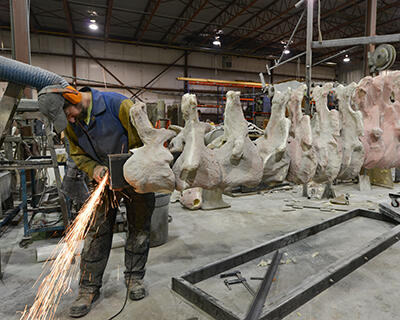
Titanosaur: Next, they put all the casts together to make the entire skeleton. This was a big job and a long process. They attached the bones to a large metal frame with glue and other materials. Then they welded together parts of the metal frame.
Titanosaur: They made sure to add every bone—like the toes on my feet and the teeth in my head!
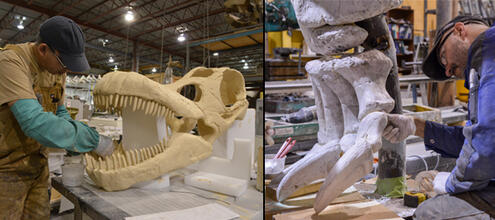
Bruno: But you’re so tall. How did workers reach all the different parts of your body?
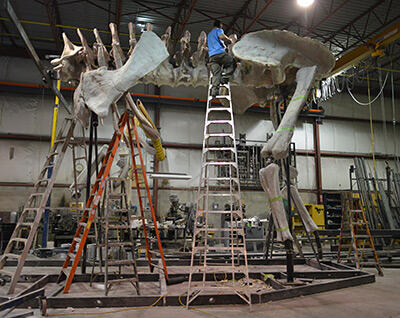
Titanosaur: As you can imagine, many jobs required a ladder!
Bruno: How did the workers move that huge cast into the Museum’s fossil hall?
Titanosaur: They took my cast in big pieces. Then they put the pieces together where you see me now. It was exciting to see myself come back together. They started with my back legs and hip bones, then added my front legs and backbone. Next came my neck and tail. Then they added the rest of me like my ribs and head. From start to finish, it was a team effort. And I don’t like to brag, but I think they did a fantastic job!
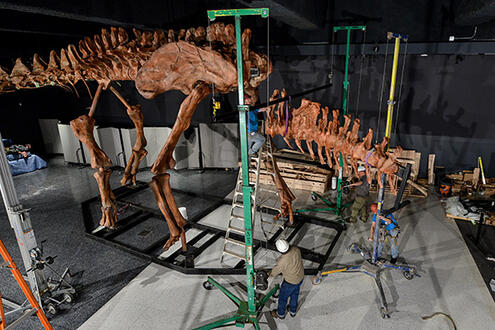
Bruno: Well, we’re almost out of time. Any last words for your fans?
Titanosaur: Yes, come visit me at the Museum! And remember, I may be the largest dinosaur on exhibit, but there are thousands of other amazing creatures here. Well, I’m off to visit my new friend, the blue whale. If you do visit, stop by and see her too!
Image Credits:
illustrations of Bruno and titanosaur, Ebony Glenn; illustration of saurapod parade, ©Raúl Martin; excavation, ©Dr. Alejandro Otero; titanosaur modeling and installation, ©AMNH/D.Finnin; all other illustrations and photos, ©AMNH.




 Biodiversity
Biodiversity
 Brain
Brain
 Genetics
Genetics
 Marine BiOLogy
Marine BiOLogy
 MicrobiOLogy
MicrobiOLogy
 PaleontOLogy
PaleontOLogy
 ZoOLogy
ZoOLogy
 AnthropOLogy
AnthropOLogy
 ArchaeOLogy
ArchaeOLogy
 Astronomy
Astronomy
 Climate Change
Climate Change
 Earth
Earth
 Physics
Physics
 Water
Water
